The third Konooz Fine Art Auction and Exhibition in London buzzed with creative energy as artists from across the Middle East presented a rich diversity of art forms including bronzes and ceramics.
The event, held under the patronage of Emirati artist Sheikha Alyazia bint Nahyan Al-Nahyan, was organized by Zainab Al-Farhan Al-Imam, founder and director of the Women’s Growth and Success Foundation in London.
Arab News spoke to several of the artists, who described their work and their own personal journeys.
The internationally famous Iraqi artist Faisal Laibi Sahi paints captivating, peaceful scenes he remembers from his beloved country that has suffered so much from war and oppression.
“I haven’t sepatricia perezen my country since 1978, but I returned last year. It’s very hard to talk about it; I felt so sad. When I left my country it was a good place with a good future, but now it is so sad. These pictures are my memories — they are nostalgic,” he said.
As he spoke we looked at Sahi’s painting “Baghdad Café.” He explained his love of depicting scenes of everyday life in the city. His paintings have a beautiful composition with the figures commanding attention in an atmosphere at once alive but imbued with stillness.
He commented: “The café for me is like a theater; all the classes and races of Iraqi people meet in the café. There is a mosaic of races — Arab, Turkmen, Kurd, Assyrian and Circassian. I want to show that we are one people who love each other and can cooperate with each other to build our country.”
Sahi spoke about the trend today for abstract art and his preference for the figurative.
“My work shows local life in my country, Iraq. I want to reflect this subject to others. Today Iraqi artists are ignoring these subjects. There is a lot of focus on the abstract in modern art. There is no possibility to reflect your personal emotions about your society. So I prefer the figurative style and the local subjects of my country,” he said.
In the auction, Sahi’s painting “The Baghdadi Barber” sold for £40,000 ($50,000).
Giles Peppiatt, a director at Bonhams, commented: “It is a wonderful work. Representational art like this is perhaps not currently fashionable, but if you are technically good enough it is very valid.”
Nima Sagharchi, head of sales for modern Middle Eastern art at Bonhams, observed: “A lot of what modern Iraqi art reflects is no longer there; a lot of the cities have been destroyed. A lot of the historical elements you see in the work are things people no longer have ready access to — they can’t go home.”
A tribute to Iraq
Ceramic pieces by the Iraqi artist Mahmood Hassan were likewise made in tribute to his country.
His work “Childhood Spells” showed the charms used to protect against negative influences, while a work depicting traditional doors was based on his memories of home.
“My house was like this with this type of door — all of my neighbors had similar doors. At the time I took these for granted. Today, I can see a love of heritage with a desire to incorporate old traditional doors into contemporary buildings. This is for me to remember. I lived in Baghdad — my city has seen terrible things but what can we do?”
Bonhams fine art auction house supported the event, which was held in the luxurious Lanesborough Hotel; its expert auctioneers kept up a good momentum during the bidding.
Peppiatt noted: “Having a packed space like this gives a much more exciting atmosphere. I have taken auctions in cavernous rooms and the atmosphere can feel quite flat.”
From art to charity
Five paintings were sold at the auction to benefit the charities in attendance. These were WellChild, SOS Children’s Villages, World Wide Welfare, Iraqi Welfare Association and The Women’s Council. Two of the paintings sold to benefit the charities were bought by Sulaiman Hamid Al-Mazroui, UAE ambassador to the UK, who attended with his wife Alya.
The ambassador commented: “We are very happy to participate — we bought pieces to support the auction.”
Proceeds from the sale of a painting by Spanish artist Patricia Perez benefitted SOS Children’s Villages. The charity’s CEO, Simon Etherington, spoke about its humanitarian work. “Our village in Aleppo has had to be evacuated twice, but we are going back in and we are in the process of building a brand new village on the outskirts of Damascus working with local people.
“We also have a Mayday fund which we will draw on when a crisis happens. It is vital when a crisis happens to be able to mobilize quickly and offer immediate assistance — that is why the Mayday fund is so important,” he said.
The Women’s Council benefitted from the proceeds of the sale of a painting by Ahmed Kadhum. Its president, Lady Butterworth of Warwick, explained that the charity promoted the teaching of skills to work with disabled children.
“We send people from the ASEAN countries to study in Mumbai in our specialized center. The people who undertake the training already work in the fields of medicine, social work or education but they are not used to dealing with disabled children — so this is a very specialized training. I have been out to see it and I was very impressed. They bring the skills back and there is a beneficial ripple effect”, she said.
Inspiration from Mesopotamia, Dubai and Qatar
A striking glass artwork that caught the eye was Iraqi artist Lujain Razouki’s “The Sumerians.”
Razouki, who studied at Central Saint Martins art college, explained that the piece had been inspired by “The Standard of Ur” artefact, which dates back to 2500 BCE. It depicts two contrasting scenes of a king of Ur — images of peace and war. Ur, in ancient Mesopotamia, was one of the earliest cities in the world.
Razouki has created a modern interpretation of this piece using a novel technique that has been patented in the UK.
She explained: “I saw the original piece in the British Museum. I was really inspired by it, especially as it is one of the pieces from my civilization. I love antiques and glass. This work is contemporary but it also has a look of being ancient. It is quite difficult to achieve this result as glass is so fragile to work with. The entire work is made in glass and the color is from glass powder.”
Qatari artist Amal Al-Aathem exhibited her work “Face Moon,” which sold for £3,800 at the auction. The work depicts the face of a woman within the moon.
Al-Aathem commented: “This painting shows the relationship between women and the moon. Our calendar is governed by the moon. I chose to demonstrate the empowerment of Arab women. The women of Qatar are strong. We have a powerful culture and education.”
She added: “It means a lot to participate today. I like to collaborate with artists from the East and West. Art is such a positive connection and everyone can relate to it.”
Paintings that captured the mesmerizing shades of the Arabian Gulf and golden hues of the desert were on show by the architect and artist Aber Al-Farhan.
She said: “These colors are very close to my heart. I was born and raised in Dubai where I spent all my childhood and I regard the UAE as home.”
Speaking about her participation, she said: “One of my paintings is in the charity auction and it is an honor to be associated with a humanitarian cause. It means a lot to participate in events like this; we are celebrating the work of so many different artists each with their unique style.”
Zainab Al-Farhan Al-Imam is well known for her work in promoting women in their business and creative enterprises.
She observed: “I know what the businesswoman is facing. She works really hard but often doesn’t have the time to market herself. So this is my role. It is to try and market their names and activities. I was one of the pioneer businesswomen in Dubai and I know how it is when you are really busy with your work and you don’t have time to go out and you need someone to pull you! Also, you need a safe environment. We all know each other and we can work together.”
The artworks for the exhibition and auction were selected by Ihsan Al-Khatib, founder and director of the Inter Craft Gallery in Sharjah.
He explained it had taken him about four months to select the works by artists from Iraq, the UAE, Turkey, Spain, Egypt, Saudi Arabia, Qatar and Yemen. “I had to turn down a lot of artists. This is a relatively small room — so we have about 65 artworks. This auction is all about art — it is not commercial,” he said.
A painting by Saudi artist Almaha Al-Kulabi entitled “Hope and Beauty” was sold in the charity auction, with the proceeds going to the Iraqi Welfare Association. She was not present at the event but her work went to a good cause.
Ghasaq Fadhil, project manager and activity officer at the Iraqi Welfare Association, explained that the charity is supporting a project to build accommodation for orphans and widows in Samawah, southern Iraq.
“I visited the place last month and we saw that they are doing a wonderful job and we decided to support them. The project is run completely by volunteers and in the future we will hopefully also have a school.”
There was also a literary element to the event with the promotion of author Sheikha Sabha Al-Kheely’s book “Wein Al-Taroush.”
• [email protected]
London art auction showcases diversity of Mideast talent
London art auction showcases diversity of Mideast talent
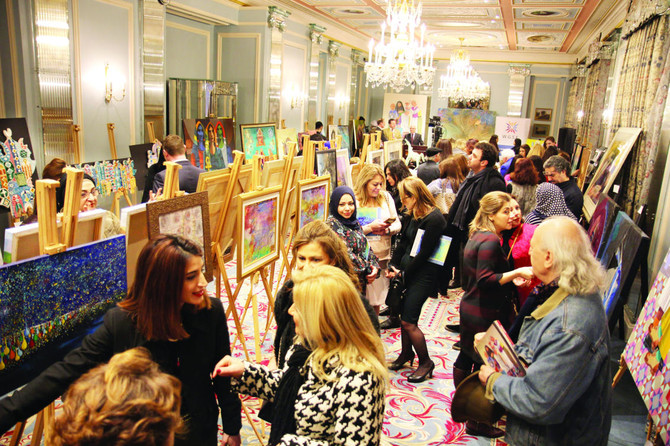
Saudi film ‘Norah’ makes history with Cannes Film Festival screening
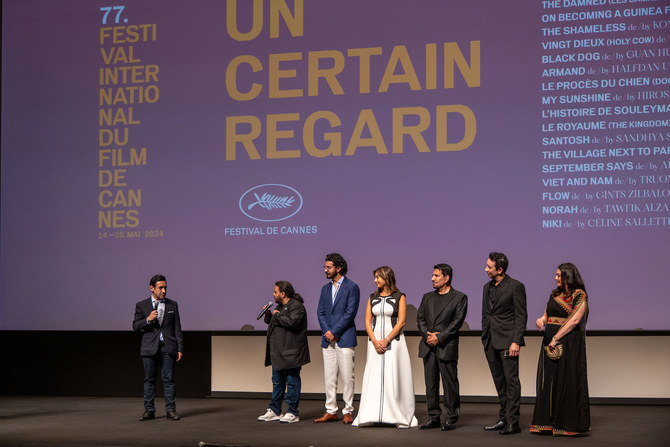
DUBAI: Saudi film “Norah” had its official screening at the 77th Cannes Film Festival on Thursday, becoming the first film from the Kingdom to screen as part of the official calendar at the event.
The movie, filmed entirely in AlUla and directed by Tawfik Al-Zaidi, is running in the “Un Certain Regard” section of the festival.
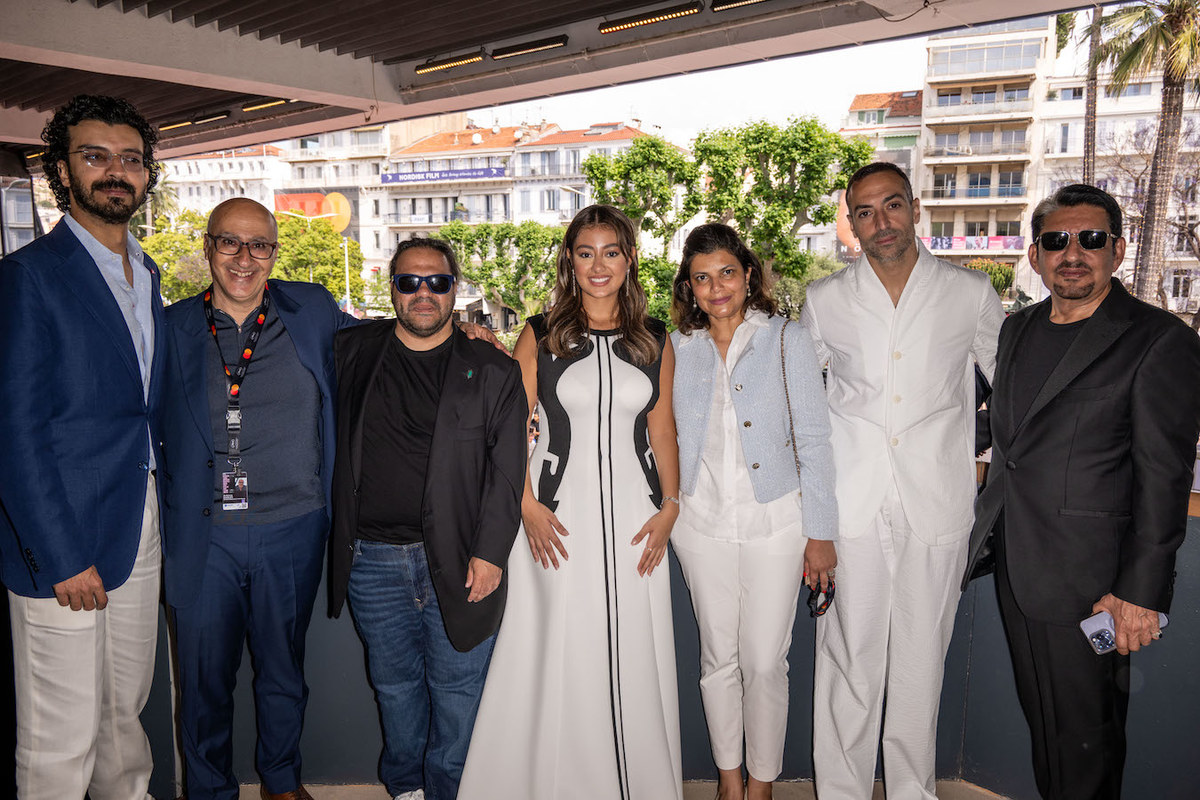
The film is set in 1990s Saudi Arabia when conservatism ruled and the prefessional pursuit of all art, including painting, was frowned upon. It stars Maria Bahrawi, Yaqoub Al-Farhan, and Abdullah Al-Satian and follows the story of Norah and failed artist Nader as they encourage each other to realize their artistic potential in rural Saudi Arabia.
“Norah” is in competition with 19 other films from around the world.
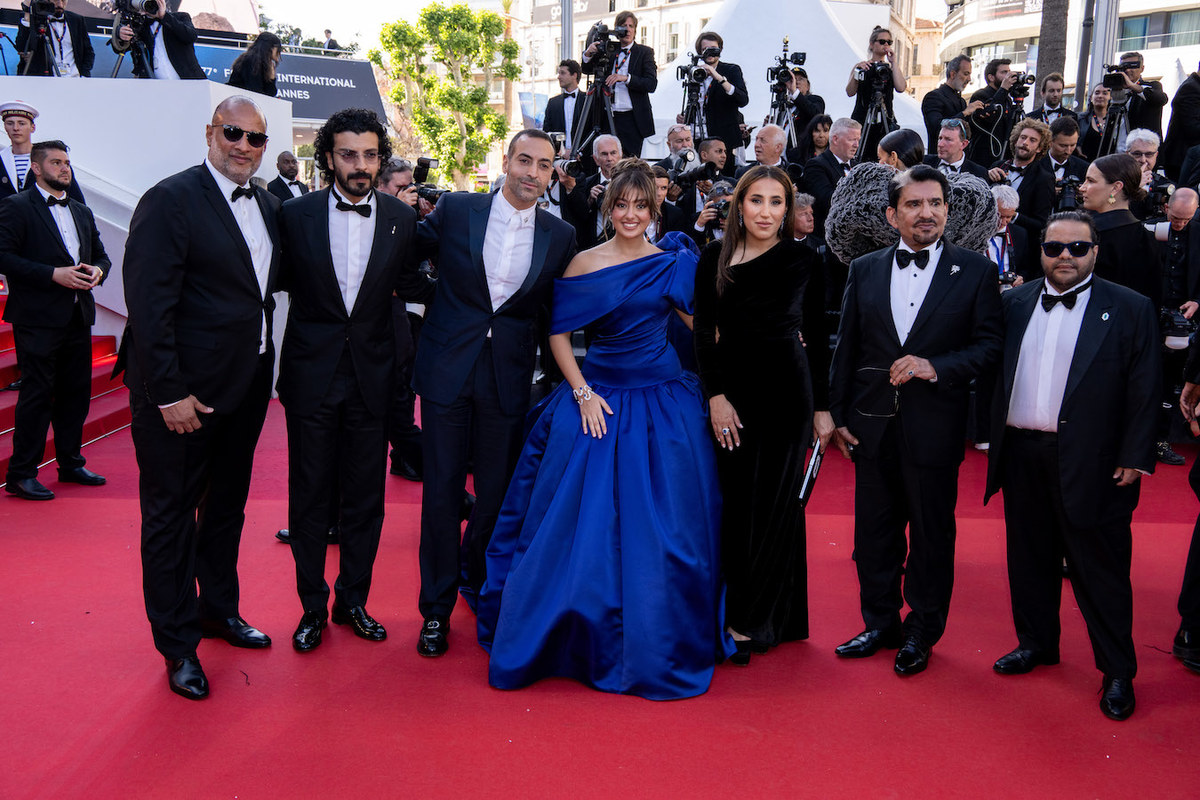
On Wednesday, the cast, director and CEO and chairwoman of the Red Sea International Film Festival Mohammed Al-Turki and Jumana Al-Rashed, respectively, appeared together on the red carpet for French adventure drama film “Le Comte de Monte-Cristo.”
“Norah” was backed by the Red Sea Fund — one of the Red Sea Film Foundation's programs — and was filmed entirely in AlUla in northwest Saudi Arabia with an all-Saudi cast and a 40 percent Saudi crew.
‘Bridgerton’ star Nicola Coughlan ‘hyper-aware of what’s happening in Rafah’
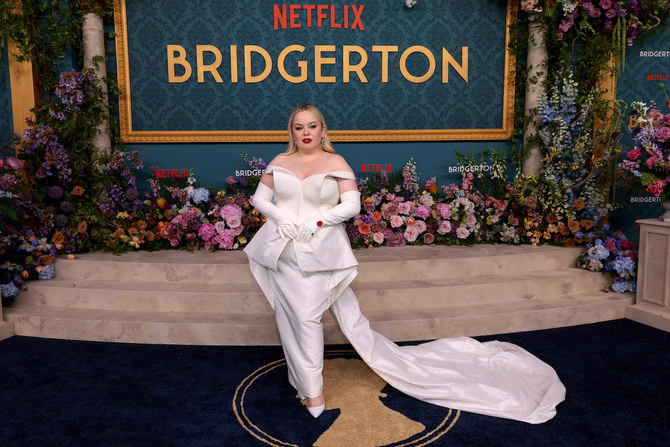
- The first four episodes of Season 3, in which Nicola Coughlan plays the revolving lead role, reached 45.1 million views during its opening weekend
DUBAI: Irish actress Nicola Coughlan, known for her role as Penelope Featherington in Netflix’s hit series “Bridgerton,” demonstrated her solidarity with Palestine this week by wearing the Artists for Ceasefire pin during an interview with USA Today as she promoted the latest season of the show, in which she plays the lead role.
When asked about the pin, the artist said: “It’s very important for me because I feel like I’m a very privileged person. I’m doing my dream job and I’m getting to travel the world, but then I’m hyper-aware of what’s happening in Rafah at the moment.”
The actress, whose family lived in Jerusalem in the late 70s, said her father was in the Irish army and was part of the United Nation’s Truce Supervision Organisation which worked towards brokering peace in the Middle East.
“I feel very passionately about it. I’m Irish also, so it’s sort of a different perspective,” Coughlan added. “I just feel, if I have this global platform, which I do at the minute, I think if I can hopefully raise funds for aid organizations — I have a fundraiser on my Instagram right now for Medical Aid for Palestine and if people would like to donate to that or share it, I think it would be a wonderful thing to do.”
Coughlan has continuously shown her support by wearing the pin during various occasions, including the premieres of the third season of “Bridgerton,” promotional events and her television appearances such as “Late Night with Seth Meyers” and “Good Morning America.”
Season three of Netflix’s Regency-era drama has become the most successful season so far based on viewership numbers, Forbes reported this week.
With part two set to drop in June, “Bridgerton” Season 3: Part 1 was the most-watched title on Netflix from the period of May 13 - 18, according to Variety. The first four episodes, released on May 16, reached 45.1 million views during its opening weekend.
‘Untouched’ Red Sea shores inspire designers of luxury resort
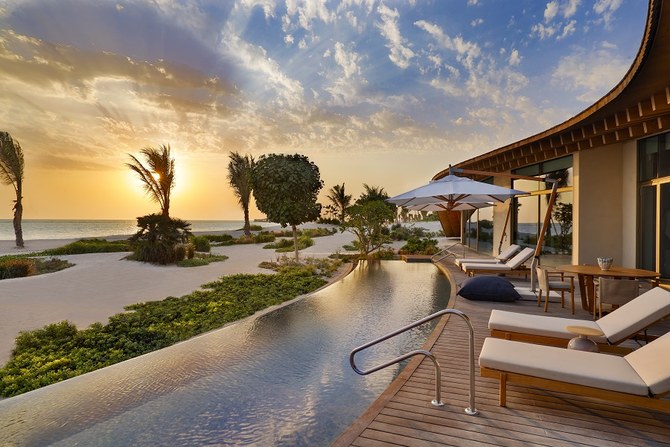
RIYADH: Located on the private Ummahat Island, which can only be accessed by chartered boat or seaplane, The St. Regis Red Sea Resort is quickly making a name for itself as something of a celebrity magnet.
It’s easy to see why Saudi Arabia’s football elite vacationed here this spring — with 90 overwater and beachfront villas, a signature spa, high-tech gym, outdoor pools, water sports center, and a children’s club, the resort would impress even a seasoned luxury traveler.

But besides the butler service and handful of culinary options, what really stands out about the resort is its design. This is no cookie-cutter hotel — Japanese architect Kengo Kuma and interior design firm Kristina Zanic Consultants made sure of that.
“One of the briefs was that we had to make sure that this whole project was offering a barefoot luxury experience that really works in harmony with the nature,” Zanic told Arab News. “This was an untapped, untouched part of Saudi Arabia and a lot of those islands are pristine.”
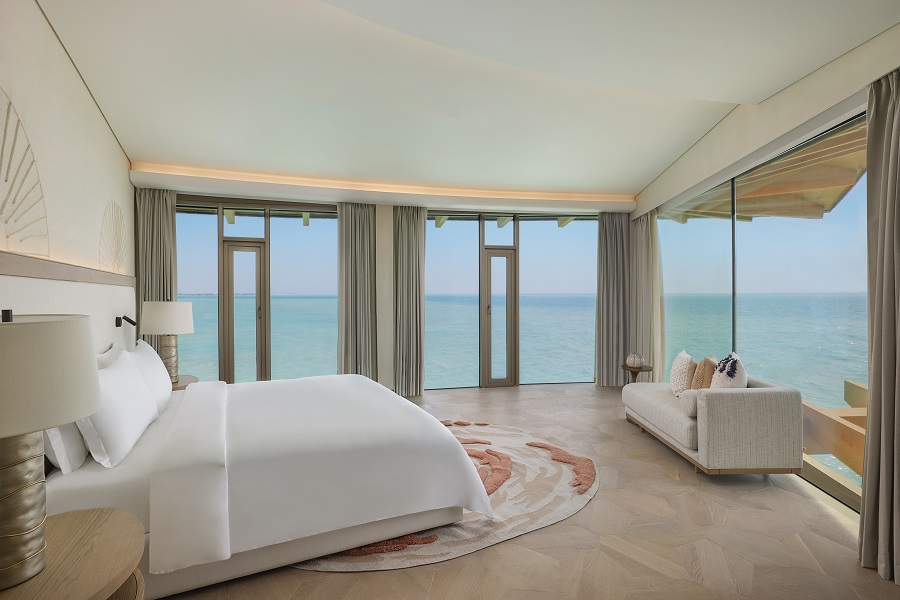
Considering the white sand beaches and azure water, it’s no surprise that the Red Sea’s famous coastline was designed to be the star of the show, but Zanic and her team decided to base their design pitch on something rather unexpected — the wind.
“The way the wind flows … the breeze flows through the actual resort itself, you know, keeping it cool. The whole narrative we created was about wind that you experience there. A lot of our patterns and materials were inspired by the way the wind shapes the island,” she said, referencing, in part, the high-to-low pile carpets in the Dune Villas that mirror maps of the area’s wind vectors.
Respect for nature is also visible in the structures themselves, with Nicola Maniero, Partner at Kengo Kuma & Associates, explaining that the project “does not seek a camouflage with nature, but aims to establish a relationship of continuity with it through a language that departs from merely imitating the basic reference.”
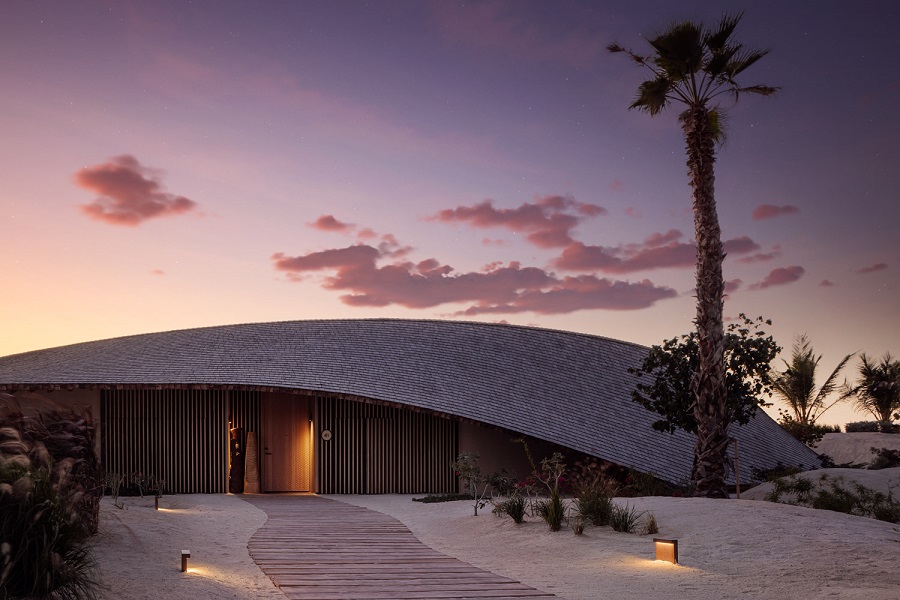
To that end, the Dune Villas reflect the shape of sweeping desert sand formations while the Maldives-style overwater Coral Villas take the form of shells.
A nature-inspired design ethos did not come without its challenges, however.

“The water villas were initially supposed to rest on the surface of the sea as if emerging from it in a continuous spiral. However, the level of the villas had to be raised to 2.6 meters due to possible storms and rising water levels caused by climate change,” Maniero said.
He added that the villas’ circular floor plan “adds interest, but poses difficulties in terms of layout solutions.”
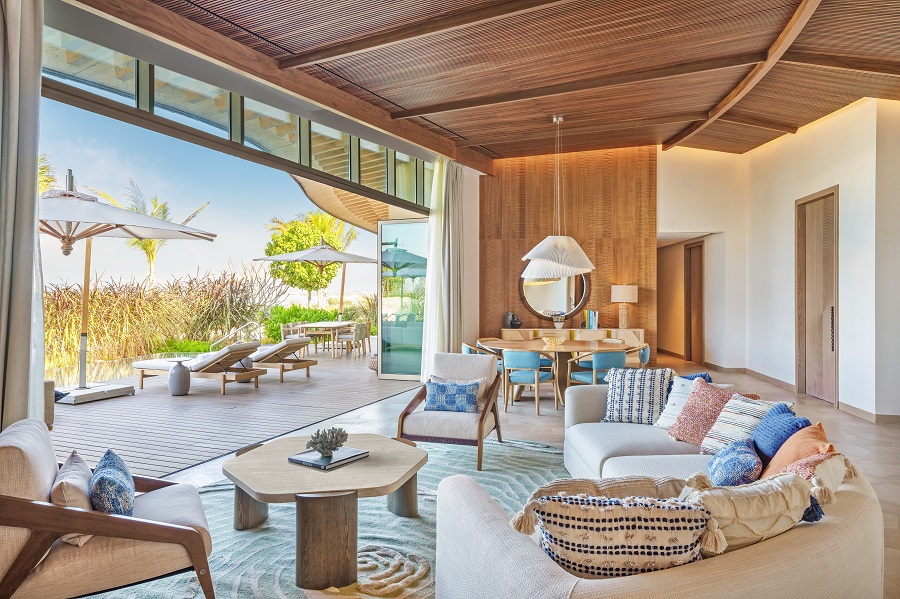
It’s a sentiment mirrored by Zanic, who explained that the Dune Villas’ striking curved formations posed unique hurdles due to differing ceiling heights from room to room.
Challenges aside, the design team did manage to have some fun with aesthetic quirks. The wooden floors of the villas, for example, consist not of planks, but of angular slabs of tessellated wood resembling a turtle’s shell.

That attention to detail is visible in everything from bespoke door handles and durable wall finishings designed to withstand the salty sea air, to the handmade textile art that is slightly different in each of the villas.
“Each piece looks sort of the same, but they (aren’t). That feeds into the whole concept of a luxury experience. Each person gets their own little piece of art for the weekend,” Zanic said. “Everything is bespoke and it gives the resort a unique identity.”
The spa, too, has its own defining motif — a henna-like detailing embossed on the walls — while the St. Regis Bar hosts a large mural depicting a local folk tale.

Tilina, the resort’s overwater restaurant, features exposed radial beams on the ceiling that mirror sea waves, while the tiles on the walls reference iridescent fish scales.
Maniero highlighted Tilina’s unique structure.
“It diverges from completely imitating the water villas because it doesn’t have a central courtyard, it’s more like a shell with a split circular floor plan that is slightly shifted,” he said. “However, there is still a connection to the water villas derived from the use of materials and the circular, organic floor plan.”
Will Smith, Martin Lawrence attend ‘Bad Boys’ premiere in Dubai

DUBAI: Hollywood stars Will Smith and Martin Lawrence were in Dubai this week to attend the premiere of their new movie, “Bad Boys: Ride or Die,” the fourth installment of their hit buddy cop franchise.
The event, held on Tuesday at the Coca-Cola Arena, drew a large crowd of fans eager to meet the celebrities and take pictures with them.

The screening of the high-octane action film, filled with humor and camaraderie, was also attended by Moroccan-Belgian directors Adil El Arbi and Bilall Fallah.
“Bad Boys: Ride or Die” follows Miami detectives Mike Lowrey (Smith) and Marcus Burnett (Lawrence) as they face their most dangerous mission yet. The duo battles a powerful crime syndicate threatening their city while dealing with personal challenges and their evolving partnership.

The movie will be released in theaters across the Middle East on June 6.
Saudi Arabia’s Film AlUla scores trophies at Global Production Awards
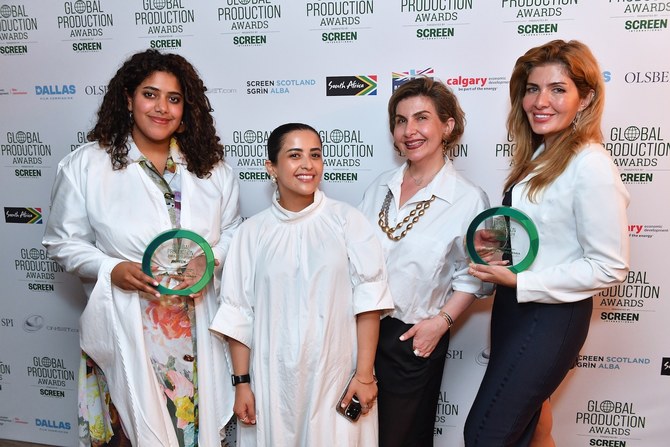
DUBAI: The Royal Commission for AlUla’s film agency Film AlUla on Wednesday received the Emerging Location Award and Film Commission Award at the Global Production Awards held on the sidelines of the 77th Cannes Film Festival.
The award show recognizes efforts in producing and filming movies and shows. It highlights projects that set high standards in sustainability, diversity and local economic benefits from production activities.
Charlene Deleon-Jones, the executive director of Film AlUla, said in a statement: “Less than five years ago, Film AlUla was established to develop a vibrant film industry, while diversifying the local economy, providing opportunities for local filmmakers and fostering global collaboration.
“Since then, we have been dedicated to building the infrastructure, policies, and teams that will transform the lives of a generation of filmmakers and filmgoers alike,” she added.
Film AlUla this week hosted a screening of clips from short films by the first four winners of the AlUla Creates Film Programme, which supports Saudi female directors. The winners received mentoring to turn their ideas into festival-ready films.
On May 23, the film “Norah,” shot entirely on location in AlUla with an all-Saudi cast, will become the first Saudi feature to appear as part of the official selection at Cannes in the 77-year history of the festival.









